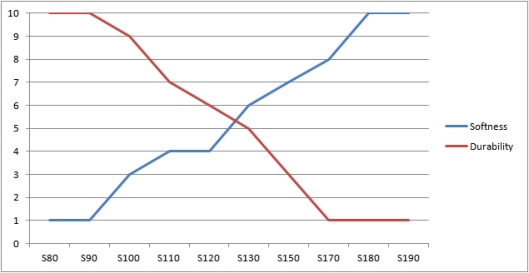Tags
When you are shopping for a suit you are likely to come up against a sales person who, in an effort to close the sale, will declare “this suit is made from Super 130s Wool!” Unfortunately the chances of them knowing what that actually means is slim. The super number of wool is actually quite important information, but it will never tell the whole story. This is a brief outline as to what it means, where it comes from and which it’s implications are for the suit you are buying.
In the Yorkshire wool markets, before the advent of modern grading technology, quality was judged by how much yarn could be spun out of one pound of raw wool. The finer the fibers, the more “hanks”—a spool totaling 560 yards of yarn—can be spun out of a single pound. Wool was thus designated as “60s count” if a pound could yield 60 hanks, 70s if 70, and so on. This measurement, and not “thread count,” or threads per inch, as many people assume, is the basis for all those confusing Super numbers. Higher-count wool commands higher prices because it can produce more yarn, and what it does yield is softer and silkier to the touch.
…
Joseph Lumb & Sons—then perhaps the most famous spinners in Yorkshire (and now part of the Bulmer & Lumb Group)—decided that the advent of 100s-count wool was an event worthy of note. Lumb bought an entire year’s lot of the wool and, in partnership with the cloth merchant H. Lesser, brought to market suitings dubbed “Lumb’s Huddersfield Super 100s.”
Nicholas Antongiavanni
Incidentally, the quote above comes from the very best article I have ever read on super numbers, and can be found here
Never allow a sales person to convince you that a high super number equals high quality. It is and always has been a measure of fineness, and in the same way that a very fine sheet of polyester makes no better suit than a thick sheet of metal the quality of the wool should always be the primary reason for choosing a cloth.
Bellow you can see a graph that very roughly gauges the Softness of a cloth and its ruggedness, and clearly there is a sweet-spot for balancing those two attributes. You are free to move from one side of the lines to the other in pursuit of a suit that meets your needs; there should be little pride in sitting further to one side than the other. Ultimately it is about finding attributes that meet your needs.
When thinking about what super number you should be aiming for I would recommend between s110 and s130 for a suit that will be worn 1,2 or 3 times per week. For me this is a sweet spot between a soft feel and rugged performance. If you intend to wear your suit every day or spend a good deal of your day moving around then consider choosing a s80 cloth, the fibres of which will be thicker and thus hold up better to wear.
When you are farther down the path of building your wardrobe you may want to experiment with more luxurious cloth in the s150, s180 and even s200 range. These suits will be very expensive, the cheapest I have seen of this quality being in excess of £2000, and more importantly should not be worn more than once a month unless you intend to replace them every two years or so.
Many men who attend black tie events for work choose to have their tuxedo in a finer cloth as the infrequent use means that it will last for many years. This is a nice compromise, the most luxurious cloths for when you wish to look your best, without subjecting your finest tailoring to the rigours of daily use.

